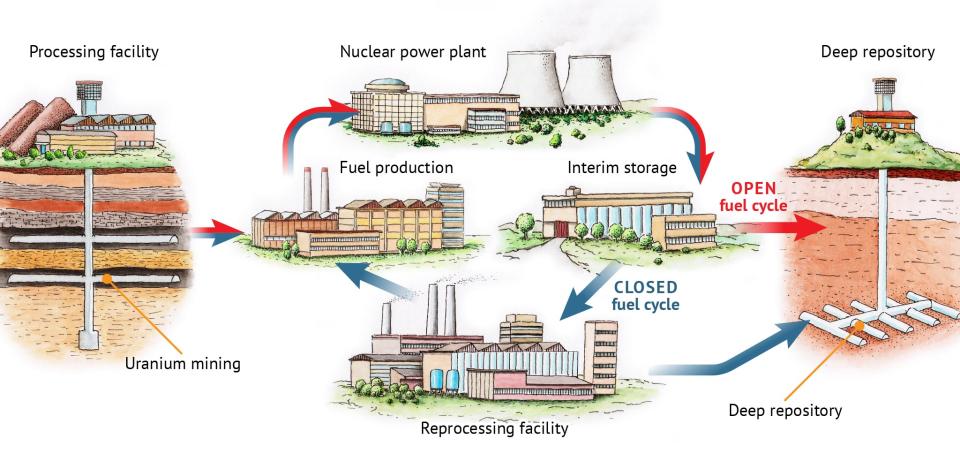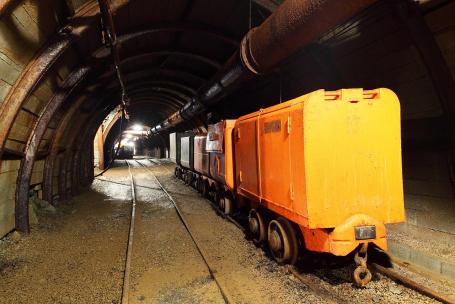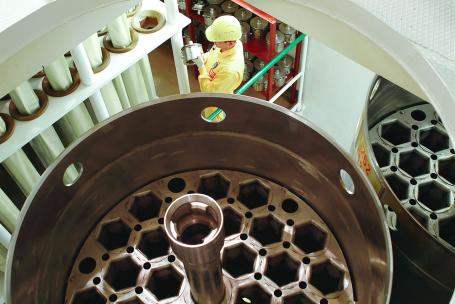
Fuel Cycle
6 min read
The nuclear fuel life-cycle starts with mining the uranium ore and the subsequent extraction of the uranium. If required, the uranium is then enriched and used to make the nuclear fuel. The reactor is then loaded with the fuel. It remains in the reactor for approximately four years and generates energy by fission. The spent fuel is then either stored in an interim storage or reprocessed to extract uranium and plutonium that is in turn used to make fresh fuel. Such a cycle is called a “closed cycle”. In case the spent fuel is not reprocessed, the fuel cycle is referred to, somewhat inaccurately, as an “open cycle”.
Mining and Production
In principle, the deep mining of uranium does not differ from the mining of other polymetallic ores. The following processing and its use in the nuclear power industry’s fuel cycle is however quite different.
The extracted uranium ore is processed to make pure uranium oxide which is then enriched in an enrichment facility in order to increase the concentration of the isotope 235U to about the 3—5% that is required for producing nuclear fuel. This enriched powder uranium is pressed to make a pellet. The pellets are inserted into a cladding made of zirconium alloy to make fuel rods. These rods are then used to produce fuel bundles. These bundles are loaded into the nuclear reactor core where a fission reaction will take place during the operation of the reactor.
The Nuclear Reactor
Four years is the average time the fuel resides in a reactor. In PWR reactors, one-quarter of the fuel is replaced annually and the remaining fuel bundles, after refueling, are placed elsewhere in the reactor core so that all of the fuel in the rods is used and the thermal and neutron stresses are reduced.
There is about 75 tons of nuclear fuel in a single 1,000 MW reactor. After its reprocessing, there is five tons of vitrified waste.
Spent Fuel
When the fuel is removed from a reactor, it is referred to as spent fuel. The frequently used term “burnt fuel” is not really correct because the fuel still contains some uranium and plutonium that can be reused. In breeder reactors, there is even more fuel produced in fuel bundles during reactor operation than was in the originally loaded fuel: 238U uranium is transmuted by neutron capture to form plutonium, which is fissionable.
Interim Storage
After the removal of the fuel from a reactor, the fuel is highly radioactive and a significant amount of heat is generated by radioactive decay. Since fuel handling is difficult, the fuel is stored in a pool near the reactor. After 3—4 years, the radioactivity of the fuel decreases by 50% and the fuel may be transported to another interim storage facility or taken for reprocessing.
Reprocessing
The first phase in the fuel cycle starts with mining the uranium ore, and it ends with the produced fuel assemblies of the fresh fuel. The following phase is represented by fuel loading of a nuclear reactor where it remains for several years.
There are several reasons for reprocessing spent nuclear fuel. The main reason is that an additional 25% of energy may be extracted from the fuel by reprocessing. Moreover, the amount of highly radioactive waste is reduced by some 80% when it is reprocessed. By fuel reprocessing, uranium and plutonium is extracted from the spent fuel. The plutonium is then used to make the MOX type fuel. Uranium, after its enrichment, is mixed with natural uranium and this mixture is used to produce the classical uranium fuel.
Closed and Open Cycle
If the spent fuel is reprocessed, the cycle is referred to as the “closed fuel cycle”. Fuel may undergo several reprocessing cycles. Plutonium may undergo about two cycles, since the resulting isotope composition would be unsuitable for the production of fuel. Uranium may undergo more cycles. If the spent fuel is just stored in an interim storage and not reprocessed, the cycle is referred to, somewhat incorrectly, as an “open fuel cycle”.
Spent fuel may also be used in new technologies to generate additional energy by fragmentation reactions in the so-called transmutation reactors.
So far, the nuclear power stations of the world have generated 290,000 tons of waste of which some 90,000 tons have been reprocessed.
Final Deposit
Highly radioactive waste, be it either spent fuel or concentrated reprocessing waste, must be isolated from the environment for a very long time. For this purpose, final deep geological repositories are used. The fuel will be safely isolated for tens of thousands of years in these repositories. However, putting fuel deposits in final repositories has not yet started. The reason is that until now, not much spent fuel has been generated and there is new technology under development. The ADTT technology (Accelerator Driven Transmutation Technology) could substantially reduce the amount of generated waste or even eliminate the radioactive waste altogether and transform it into isotopes with much shorter half-lives that do not require long-term storage.







